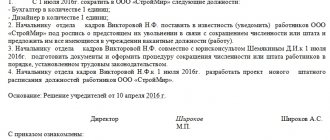Recruitment: basic concepts and terms
In order for the “personnel issue” in your company to be resolved effectively and competently, it is necessary to approach the matter of personnel selection consistently and professionally.
The phrase “cadres decide everything” belongs to I. Stalin: if we ignore the political aspect, one cannot help but appreciate the wisdom of this statement.
This expression became popularly loved and is widely used to this day.
As a recruiter with 5 years of experience, I can confirm: the well-being of the company, the atmosphere within the team, the development prospects of the company and much more depend on the personnel.
The company’s HR department (the term comes from the English “Human Resource” - “human resources”) is engaged in personnel selection, taking into account the long-term development prospects of the organization. Sometimes companies resort to the help of head hunters, which literally translates as “head hunter.”
This is the name given today to professional recruiting agents who “lure” already working employees from one company to another at its request, offering better working conditions.
For a successful business, it is necessary that employees are not only talented in their fields, but also able to work effectively in a team.
Finding qualified personnel is the first thing the head of a new organization has to do.
Recruiting employees is also relevant for an already existing company if there is suddenly a stagnation in work or prospects for expanding the field of activity arise.
To begin with, let me remind you of the meaning of basic terms and concepts.
This will help you understand the terms better.
Recruitment is a targeted effort to attract candidates to the company who have the qualities and skills necessary for the current and long-term needs of the organization. In other words, this is the search, testing and hiring of people who can and want to work, have the competencies and knowledge required by the employer and share the company’s values.
Applicants are persons applying for a vacant position.
A job description is a document regulating the range of responsibilities and rights of employees, as well as the nature of their official relationships with other employees.
Recruitment agencies are professional organizations that act as intermediaries between a company that needs to find employees and job seekers.
High-quality selection of employees:
- increases company profits;
- increases labor productivity;
- allows the company to develop.
An unprofessional approach to hiring employees is fraught with delays in completing work, a decrease in company income, and disruptions in business processes. Ultimately, you will have to return to the starting point - start searching and spend money and time recruiting new employees. System errors in the selection process - I have observed this in practice - significantly increase the company's costs.
Personnel selection
Speaking about the selection of candidates, namely all sorts of different tests, we can no longer make a distinction between direct employers and agencies. They use all selection methods equally, and their choice depends on the knowledge and experience of a particular recruiter.
So, the main methods for selecting candidates:
- Analysis of resumes and other documents - screening based on formal criteria;
- Telephone interview - screening according to formal requirements, determining the level of expected salary;
- Interview - in addition to the necessary competencies, the candidate’s appearance and demeanor are also assessed;
- Stress interview - level of stress resistance, pattern of behavior in a stressful situation;
- Questioning - compliance with procedures, willingness to make contact;
- Testing - psychological, level of intelligence, etc.;
- Essay - the ability to express one's thoughts in writing;
- Solving business cases is a model of behavior in a given situation;
- Logical and associative tasks - behavior, reaction to questions, logical thinking abilities;
- Infusion into working groups - evaluation of communications, work proposals;
- Collection of recommendations - recommendations from employers, colleagues from previous places of work;
- Collecting information on social networks.
I would also like to note some unconventional and largely controversial selection methods:
Anthropological selection method
Anthropological - the candidate’s abilities, his intellectual and creative abilities are assessed based on the structure of his skull: the size of the brow ridges, the position of the lips and ears, etc.
Graphological selection method
Graphological - the applicant’s handwriting is analyzed, based on this analysis, conclusions are drawn about the individual characteristics of the candidate. According to graphologists, graphological examination allows one to evaluate a person’s personal and business qualities. It must be said that this method is used mainly in Europe. In Russia it is not widespread, and graphology itself is often classified as a pseudoscience.
Astrological selection method
Astrological - the candidate's zodiac sign is analyzed. It is believed that by the zodiac sign one can determine the personal and business qualities of a candidate, the success of his entry into the team, and his predisposition to certain types of work, professions and positions. In Russia, again, this selection method is not common.
It is rarely used by professional recruiters (well, perhaps out of female curiosity). But a male leader can resort to him at the most unexpected moment and make a choice in favor of a candidate based on his zodiac sign.
Numerological selection method
Numerological - the same story with numerology. The candidate is assessed by date of birth (the numbers themselves, their order, combination, etc.).
Palmistry
Palmistry - palmists evaluate a person’s abilities based on the parameters of the palm. They even say that palmists can evaluate professional qualities.
The boom in attracting palmists, magicians, psychics and other people of outstanding abilities occurred in the “dashing” 90s. Turning to such “specialists” removes the responsibility for making a decision on choosing a candidate, but the quality of assessing candidates is difficult to assess.
Polygraph
Polygraph (Lie Detector) is the least exotic method and has a real scientific basis. Used for over 100 years. The average reliability level of a lie detector is 95%. Recently it has become increasingly widespread.
To sum up the unconventional selection methods, I will say that I have formed a rather entertaining image of a recruiter-astrologer-numerologist-palm reader with a polygraph at the ready. Do I need to say that I don’t know such a specialist? And you?










